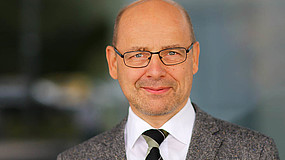
Mechatronic Systems - Part 3 (EM degree program)
Power Electronics/Electrical Drives (EE degree program)
Winter semester:
Lecture 2.66 SWS (total 20 lectures)
Seminar 2 SWS (total 15 seminars)
Practical 1.33 SWS - 5 attempts (total 20 h)
Final performance:
Examination PK 120 for EE
Examination PK 240 (pro rata 120 min) for EM
Part 1 Power electronics
1 Introduction to power electronics
1.1 Characteristics of power electronic circuits
1.2 Basic functions of power converters
2 Semiconductor valves
2.1 Power semiconductor diode
2.1.1 Stationary characteristic behavior
2.1.2 Switching behavior
2.2 Thyristor
2.2.1 Stationary characteristic behavior
2.2.2 Phase angle control
2.2.3 Blocking voltage - reverse voltage
2.2.4 Extinguishing circuit for thyristors
2.3 Bipolar transistor for switching operation
2.3.1 Design and mode of operation
2.3.2 Stationary characteristic behavior
2.3.3 Darlington transistor
2.4 MOS field-effect transistor for switching operation
2.4.1 Design and mode of operation
2.4.2 Stationary characteristic behavior
2.5 Insulated Gate Bipolar Transistor (IGBT)
2.6 Gate Turn Off Thyristor (GTO )
3 Power loss and cooling of electronic valves
3.1 Power considerations for converter circuits
3.2 Passing losses
3.3 Blocking losses
3.4 Switching losses
3.5 Thermal equivalent circuit diagram
3.6 Demonstration task
4 Grid-connected uncontrolled converter circuits
4.1 Single-pulse rectifier
4.1.1 Single-pulse rectifier with resistive load
4.1.2 Single-pulse rectifier with smoothing capacitor
4.1.3 Single-pulse rectifier with reverse voltage
4.1.4 Single-pulse rectifier with ohmic-inductive load
4.1.5 Single-pulse rectifier with freewheeling diode
4.2 Two-pulse rect ifier
4.2.1 Midpoint circuit
4.2.2 Bridge circuit
4.2.3 Comparison midpoint-bridge circuit
4.3 Three-pulse rectifier - M3 circuit
4 .4 Six-pulse rectifier - B6 circuit
4.5 Comparison bridge circuit B6 - midpoint circuit M3
5 Mains-controlled controllable rectifier circuits
5.1 Single-pulse rectifier with resistive load
5.2 Fully controlled two-pulse circuit
5.3 Semi-controlled B2 circuit
5.3.1 Symmetrical B2 circuit, semi-controlled
5.3.2 Unbalanced B2 circuit, semi-controlled
5.4 Fully-controlled M3 circuit
5 .5 Fully-controlled B6 circuit
5.5.1 Fully-controlled bridge circuit with smoothed DC current
5.5.2 Fully-controlled B6 bridge circuit with resistive load
5.5.3 Dynamic response to firing angle changes
5.5.4 Transmission response of the control unit and the converter
5.5.5 Linearization of the transmission response
5.6 Semi-controlled B6 bridge switching
5.7 Mains commutation (B6 circuit)
5.7.1 Representation of the commutation process
5.7.2 Load characteristics during commutation
5.7.3 Mains feedback effects during commutation
6 Power converter circuits for adapting direct current systems
6.2 Buck converter
6.2 Buck converter
6.3 DC converter with push-pull stage and HF transformer
7 Power converter circuits for controlling electric drives
7.1 Controlling speed and torque using power electronic actuators
7.2 Pulse controllers
7.2.1 DC controller for 1-quadrant operation
7.2.2 DC controller for 2-quadrant operation with voltage reversal
7.2.3 DC controller for 2-quadrant operation with current reversal
7.2.4 DC/DC converter for 4-quadrant operation
7.2.5 Single-phase pulse inverter
7.3 Inverter
7.3.1 Inverter with uncontrolled rectifier and inverter with intermediate voltage circuit
7.3.2 Pulsed operation of the inverter
7.3.3 Pulsed operation of the inverter
Part 2 Electric drives
1 Analysis of actuating and movement processes
1.1 Forces and torques
1.1.1 Gearbox
1.1.2 Equation of motion of mechanical systems
1.1.3 Motor-load operating point
1.2 Elasticities and gear backlash
1.2.1 Transmission behavior of a two-mass system
1.2.2 Transmission behavior of a gear backlash
1.2.3 Derivation of transfer functions
2 DC shunt machine (GNM)
2.1 Operating behavior and equivalent circuit diagram
2.2 Speed position and characteristic diagrams
2.2.1 Resistance position
2.2.2 Field position
2.2.3 Armature voltage position
3 Three-phase asynchronous machine (ASM)
3.1 Mode of operation and design
3.2 Characteristic behavior
3.3 Speed control options
3.3.1 Frequency control
3.3.2 Stator voltage control
3.3.3 Star-delta starting
3.4 Squirrel cage configurations
4 Operating modes of electric drives
4.1 Continuous operation, short-time and intermittent operation
4.2 Determining the type power using the torque RMS method